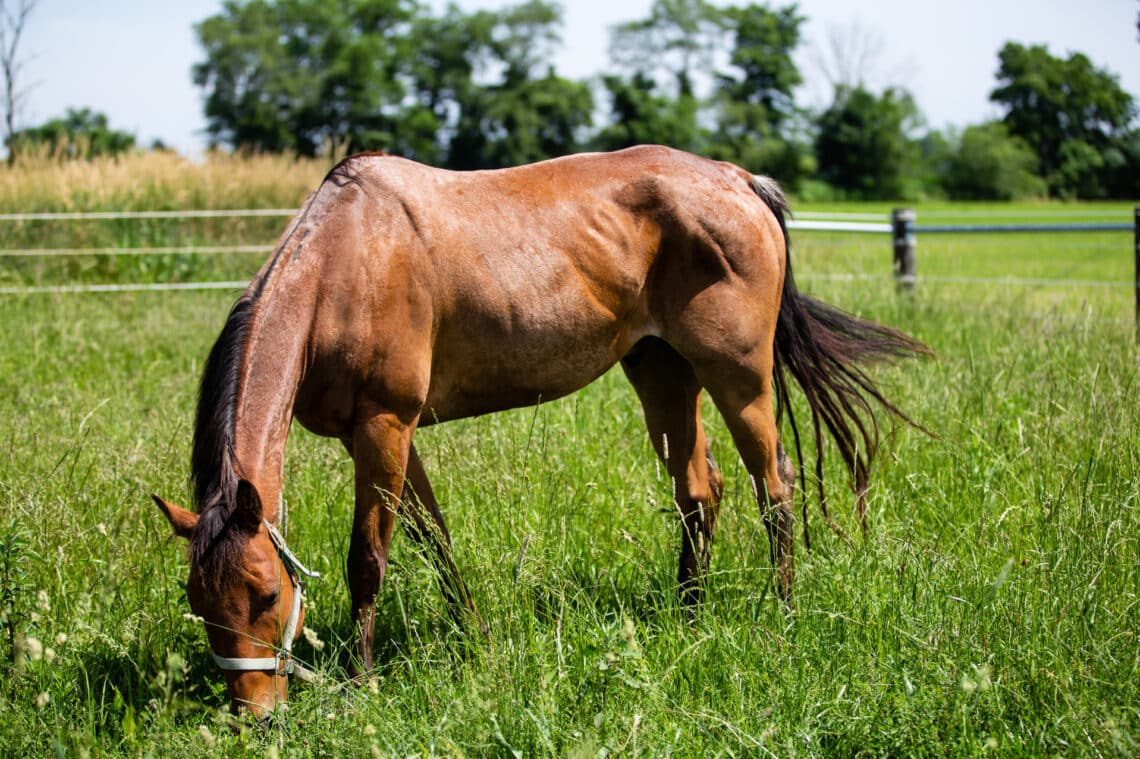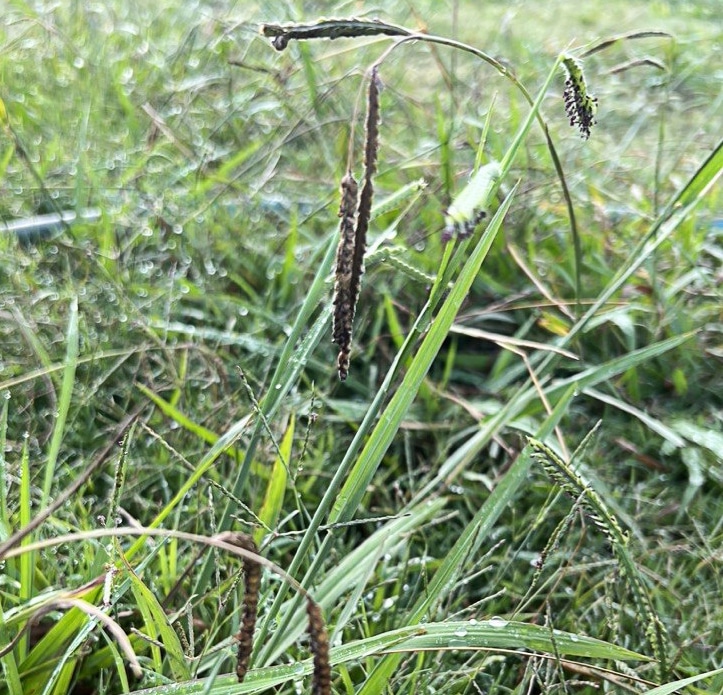
Equine nutritionist LARISSA BILSTON explains what mycotoxins are, the signs your horse is affected, and what you can do to minimise the risks.
Horse owners are becoming increasingly aware of the deleterious effects of mycotoxins on horse health, behaviour and performance. Symptoms can be mild or acute and are not always easy to pinpoint as individuals tend to respond to them differently.
What are mycotoxins?
Fungi love growing in warm, wet conditions and unfortunately, this includes the fungi that grow on grass, grass seeds, hay, silage, grains and stored horse feeds, producing harmful and invisible mycotoxins.
Mycotoxins: Mycotoxins are harmful substances produced by bacteria and fungi that grow on pastures, hay/silage and grains. Mycotoxins are invisible and cannot be detected by human smell or taste.
Endophytes: These fungi live in a symbiotic (mutually beneficial) relationship with pasture plants. Many pasture species such as ryegrass and fescue carry endophytes which provide the plant with enhanced resistance to some insect pests;, increase seed production; and improve seedling establishment, photosynthesis and drought tolerance. Unfortunately, the mycotoxins produced by endophyte fungi are toxic to horses.
The effects of mycotoxins
After ingestion, mycotoxins interfere with gastrointestinal function, disrupting the gut lining and the microflora of the digestive tract before being absorbed into the bloodstream where they can impact on many organs, sometimes causing permanent damage.
Because of the many types of mycotoxins and the variety of organs potentially affected, symptoms can vary widely and may include:
- Itchy skin
- Head flicking, head pressing or facial tremors
- Reduced immune function
- Uncharacteristic spookiness
- Unpredictable or ‘naughty’ behaviour
- Sunburn or photosensitivity
- Greasy heel or summer mud fever
- Infertility, abortion, or stunted foals
- Reduced milk production in broodmares
- Lethargy or anaemia
- Dull coat or patchy hair growth
- Cough or runny nose
- Muscle tightness or swollen lower limbs
- Uneven sweat patterns or ‘hot flushes’
- Bloated belly
- Lack of coordination, staggers
- Shuffling gait or lameness
- Ill-thriftiness or weight loss despite good feed.

Symptom severity depends on the type and amount of toxin present and the individual’s immunity or tolerance to mycotoxins. It is not unusual for one horse in a paddock to be much more affected than others on identical feeds.
Reducing mycotoxin ingestion
Where practical, do not allow horses to ingest mycotoxin contaminated feeds:
- Do not feed mouldy or musty hay or hard feeds.
- In some instances the source of mycotoxins may not be obvious, such as when fungi is growing in pastures. If symptoms are severe, remove horses from the affected paddocks.
- Choose endophyte-free species when replanting pastures.
Seasonal management of low-level mycotoxin ingestion is easily achieved by adding a quality mycotoxin binder to horse feeds during times of high risk.

Rainfall and high humidity increase the presence of fungi and mycotoxins in pastures and the environment. The presence of black or sticky seed heads in some species of grass flowers (e.g. ryegrass, fescue and paspalum) signal danger for mycotoxin ingestion. In other pasture types fungi are likely to be invisible, so keep an eye out for larger fungi growing on timber, fence posts and on the ground as an indicator of general fungal activity.
Toxin binders work in one of three ways. They can:
- Physically adsorb (trap) the toxin due to the porous structure of the binder and intermolecular forces.
- Chemically bind to the toxin – this produces the strongest bonds.
- Bio-transform the toxin via enzymes (although this is not strictly toxin binding, it is an effective means of managing feed mycotoxins and can be included in a toxin binder blend).
Mycotoxins have differing chemical and molecular properties which means that a single binder is not effective against all mycotoxins. The most common toxin binders used in animal health are:
- Inorganic binders: Mainly mineral clays including aluminosilicates, bentonite, montmorillonites and zeolite which bind polar mycotoxins due to their electromagnetic charges and non-polar toxins due to the porous physical structure of the molecule. Aflatoxins have a flat structure so they can be trapped between the layers of mineral clay like meat in a sandwich. Once trapped in the clay, the intermolecular forces between atoms tighten the bond. The porous physical structure (shape) of the binder and polarity of toxins and binders are some factors that affect this process. Other mycotoxins such as deoxynivalenol (DON) and zearalenone (ZEN) are not as flat so are harder for mineral clays to trap.
- Organic binders (also known as biopolymers): These are complex indigestible carbohydrates such as cellulose, chitosan, polysaccharides from the cell walls of yeast, and some bacteria such as glucomannans, mannan-oligosaccharides (MOS) and peptidoglycans. Organic binders often use polarity to attract the oppositely charged mycotoxins. This makes them very effective at binding the aflatoxins sometimes found in grains and stock feeds. Yeast based binders are also able to bind trichothecene mycotoxin (T-2), DON and ochratoxin. Some of the most common grass endophyte toxins are not polar so cannot be bound by yeast-based toxin binders.
- Activated charcoals: These adsorb due to their porous structure and are commonly used to treat some instances of drug overdose and poisoning in humans and animals. These binders are not advised for daily use as they will also bind medications and nutrients including minerals, making them unavailable to the horse.
- Toxin deactivators: These include enzymes and organic acids. Biotransformation via enzymes allows very targeted deactivation of specific mycotoxins and is particularly suitable for non-polarised or non-adsorbable toxins. The non-toxic metabolites produced are able to pass harmlessly through the digestive tract.
- Synthetic polymers: These polymers (such as cholestyramine) are binders more frequently used in industrial applications.
What makes a good toxin binder?
Although many substances have toxin binding properties, to be effective and safe in animal nutrition it is important that they:
- Are capable of binding the targeted mycotoxins.
- Hold on to the toxin through the remainder of the journey through the gastrointestinal tract.
- Specifically bind toxins, leaving important nutrients such as vitamins and minerals, and medications available for uptake into the bloodstream.
- Be safe as a feed additive, non-toxic to animals.
- Show scientifically demonstrated efficacy within animals at the lowest recommended dosage.
The effectiveness of toxin binders can be improved by combining a number of active ingredients to broaden the range of toxins they can bind in the gut. They may also provide additional nutraceutical support through the addition of antioxidants, botanical extracts and probiotics. When selecting a toxin binder for your horse, ask for evidence that it doesn’t tie up vitamins, minerals and other important nutrients.
Management of severely mycotoxin affected horses may be enhanced with the addition of antioxidants such as organic selenium, superoxide dismutase, vitamin C and vitamin E to reduce the negative impact of free radical tissue damage associated with the presence of toxins in the body.
Remember: Reduce the risk of aflatoxin contamination by only feeding forages, grains and feeds that have been well stored. Discard any damp, stained or smelly feed. If toxin binders do not rapidly assist your horse with mild symptoms, remove the horse from the pasture and seek veterinary advice.
Larissa Bilston, BAgrSc (Hons) is the Equine Nutritionist for Farmalogic.



